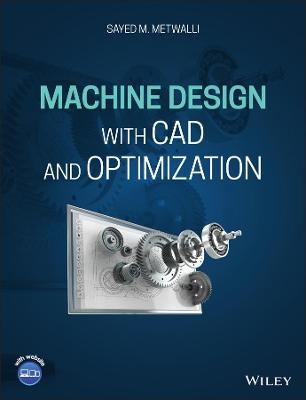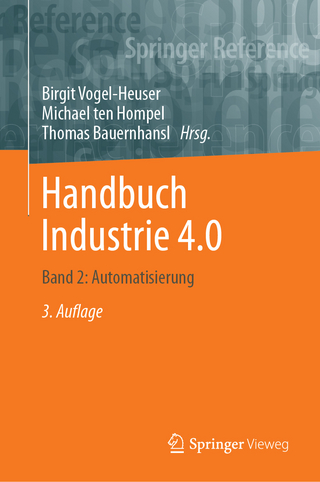
Machine Design with CAD and Optimization
John Wiley & Sons Inc (Verlag)
978-1-119-15664-2 (ISBN)
Machine Design with CAD and Optimization offers the basic tools to design or synthesize machine elements and assembly of prospective elements in systems or products. It contains the necessary knowledge base, computer aided design, and optimization tools to define appropriate geometry and material selection of machine elements. A comprehensive text for each element includes: a chart, excel sheet, a MATLAB® program, or an interactive program to calculate the element geometry to guide in the selection of the appropriate material.
The book contains an introduction to machine design and includes several design factors for consideration. It also offers information on the traditional rigorous design of machine elements. In addition, the author reviews the real design synthesis approach and offers material about stresses and material failure due to applied loading during intended performance. This comprehensive resource also contains an introduction to computer aided design and optimization. This important book:
Provides the tools to perform a new direct design synthesis rather than design by a process of repeated analysis
Contains a guide to knowledge-based design using CAD tools, software, and optimum component design for the new direct design synthesis of machine elements
Allows for the initial suitable design synthesis in a very short time
Delivers information on the utility of CAD and Optimization
Accompanied by an online companion site including presentation files
Written for students of engineering design, mechanical engineering, and automotive design. Machine Design with CAD and Optimization contains the new CAD and Optimization tools and defines the skills needed to generate real design synthesis of machine elements and systems on solid ground for better products and systems.
SAYED M. METWALLI, is Professor Emeritus of Machine Design and past Chair of Mechanical Design and Production Department, Cairo University, Egypt. He received a BS (Mech. Eng.) with honor from Cairo University (1965) and MS and PhD (Mech. Eng.) from State University of New York at Buffalo, USA, (1970) and (1973) respectively. Metwalli has conducted research and taught at North Carolina State University, the University of Central Florida, USA, and Kuwait University, and holds a US patent. His research interests are in design optimization theory, developing algorithms, and CAD/CAM software, with particular emphasis on optimum synthesis of mechanical components and systems including dynamics and controls for multitude of applications. He has conducted sponsored research with DOD/NRL, UNESCO, IBM-UK, NSF, EPA, USAID, and CU and has published more than 150 papers in journals and peer reviewed international conferences. His work with various manufacturers successfully implemented CAD and design optimization in their product design and development. He is an ASME Life Fellow, registered mechanical design consultant, and has been a registered PE in Florida.
Preface xxiii
Acknowledgments xxvii
About the Companion Website xxix
Part I Introduction and Design Considerations 1
1 Introduction to Design 3
1.1 Introduction 6
1.2 Phases of Design 8
1.3 Basic Mechanical Functions 9
1.4 Design Factors 11
1.5 Synthesis Approach to Design 12
1.6 Product Life Cycle 13
1.7 Business Measures 14
1.8 Research and Development Process in Product Cycle 15
1.9 Teamwork for Product or System Design 16
1.10 Design and Development Case Study 16
1.11 Units and Fundamentals 16
1.12 Summary 26
2 Design Considerations 31
2.1 Mathematical Modeling 34
2.2 Calculation Tools 57
2.3 Design Procedure 60
2.4 Manufacturing Processes 62
2.5 Standard Sets and Components 72
2.6 Codes and Standards 72
2.7 Summary 73
Part II Knowledge-Based Design 79
3 Introduction to Computer-Aided Techniques 81
3.1 CAD and Geometric Modeling 82
3.2 Geometric Construction and FE Analysis 84
3.3 CAD/CAM/CAE and Advanced Systems 85
3.4 Virtual Reality 87
3.5 Summary 89
4 Computer-Aided Design 91
4.1 3D Geometric Modeling and Viewing Transformation 95
4.2 Parametric Modeling 111
4.3 CAD Hardware and Software 135
4.4 Rendering and Animation 135
4.5 Data Structure 146
4.6 Using CAD in 3D Modeling and CAM 149
4.7 Summary 149
5 Optimization 155
5.1 Introduction 158
5.2 Searches in One Direction 167
5.3 Multidimensional: Classical Indirect Approach 173
5.4 Multidimensional Unconstrained Problem 179
5.5 Multidimensional Constrained Problem 200
5.6 Applications to Machine Elements and Systems 209
5.7 Summary 213
6 Stresses, Deformations, and Deflections 221
6.1 Loads, Shear, Moment, Slope, and Deflection 227
6.2 Mathematical Model 253
6.3 Simple Stresses, Strains, and Deformations 254
6.4 Combined Stresses 264
6.5 Curved Beams 279
6.6 Strain Energy and Deflection 283
6.7 Columns 288
6.8 Equivalent Element 296
6.9 Thermal Effects 297
6.10 Stress Concentration Factors 300
6.11 Finite Element Method 302
6.12 Computer-Aided Design and Optimization 323
6.13 Summary 333
7 Materials Static and Dynamic Strength3 43
7.1 Material Structure and Failure Modes 348
7.2 Numbering Systems and Designations 358
7.3 Heat Treatment and Alloying Elements 362
7.4 Material Propertied and General Applications 366
7.5 Particular Materials for Machine Elements 381
7.6 Hardness and Strength 383
7.7 Failure and Static Failure Theories 385
7.8 Fatigue Strength and Factors Affecting Fatigue 397
7.9 Fracture Mechanics and Fracture Toughness 413
7.10 Computer-Aided Selection and Optimization 419
7.10.1 Material Properties: Carbon Steel 419
7.11 Summary 428
8 Introduction to Elements and System Synthesis 439
8.1 Introduction 441
8.2 Basic and Common Machine Elements 442
8.3 Reverse Engineering 469
8.4 Sample Applications 470
8.5 Computer-Aided Design 476
8.6 System Synthesis 479
8.7 Computer-Aided Assembly 480
8.8 Summary 480
Part III Detailed Design of Machine Elements 487
Section A Basic Joints and Machine Elements 489
9 Screws, Fasteners, and Permanent Joints 491
9.1 Standards and Types 494
9.2 Stresses in Threads 497
9.3 Bolted Connections 498
9.4 Bolt Strength in Static and Fatigue 507
9.5 Power Screws 511
9.6 Permanent Joints 518
9.7 Computer-Aided Design and Optimization 527
9.8 Summary 532
10 Springs 539
10.1 Types of Springs 542
10.2 Helical Springs 542
10.3 Leaf Springs 567
10.4 Belleville Springs 574
10.5 Elastomeric and Other Springs 576
10.6 Computer-Aided Design and Optimization 576
10.7 Summary 579
11 Rolling Bearings 585
11.1 Bearing Types and Selection 588
11.2 Standard Dimension Series 590
11.3 Initial Design and Selection 592
11.4 Bearing Load 595
11.5 Detailed Design and Selection 601
11.6 Speed Limits 609
11.7 Lubrication and Friction 609
11.8 Mounting and Constructional Details 610
11.9 Computer-Aided Design and Optimization 611
11.10 Summary 617
12 Journal Bearings 621
12.1 Lubricants 624
12.2 Hydrodynamic Lubrication 629
12.3 Journal Bearing Design Procedure 641
12.4 Boundary and Mixed Lubrication 646
12.5 Plain Bearing Materials 648
12.6 CAD and Optimization 653
12.7 Summary 661
Section B Power Transmitting and Controlling Elements 667
13 Introduction to Power Transmission and Control 669
13.1 Prime Movers and Machines 671
13.2 Collinear and Noncollinear Transmission Elements 671
13.3 Power Control Elements 675
13.4 Computer-Aided Design of a Power Transmission System 676
13.5 Summary 681
14 Spur Gears 683
14.1 Types and Utility 687
14.2 Definitions, Kinematics, and Standards 688
14.3 Force Analysis and Power Transmission 699
14.4 Design Procedure 701
14.5 Critical Speed 732
14.6 CAD and Optimization 734
14.7 Constructional Details 742
14.8 Summary 747
15 Helical, Bevel, and Worm Gears 755
15.1 Helical Gears 758
15.2 Bevel Gears 776
15.3 Worm Gears 781
15.4 Gear Failure Regimes and Remedies 787
15.5 Computer-Aided Design and Optimization 787
15.6 Constructional Details 794
15.7 Summary 795
16 Flexible Elements 801
16.1 V-belts 804
16.2 Flat Belts 818
16.3 Ropes 823
16.4 Chains 831
16.5 Friction Drives 839
16.6 Flexible Shafts 839
16.7 Computer-Aided Design and Optimization 840
16.8 Summary 849
17 Shafts 857
17.1 Types of Shafts and Axles 859
17.2 Mathematical Model 860
17.3 Initial Design Estimate 865
17.4 Detailed Design 867
17.5 Design for Rigidity 871
17.6 Critical Speed 872
17.7 Computer-Aided Design and Optimization 873
17.8 Constructional Details 879
17.9 Summary 880
18 Clutches, Brakes, and Flywheels 887
18.1 Classifications of Clutches and Brakes 889
18.2 Cone Clutches and Brakes 889
18.3 Disk Clutches and Brakes 891
18.4 Caliper Disk Brakes 898
18.5 Energy Dissipation and Temperature Rise 899
18.6 Design Process 901
18.7 Computer-Aided Design and Optimization 902
18.8 Flywheels 904
18.9 Constructional Details 907
18.10 Summary 908
Problems 908
References 911
Internet Links 912
Appendix A Figures and Tables 913
A.1 Conversion Between US and SI Units 913
A.2 Standard SI Prefixes 914
A.3 Preferred Numbers and Sizes 915
A.4 Standard Rods, or Bars 916
A.5 Standard Joining and Retaining Elements 917
A.6 Standard Sealing Elements 920
A.7 Material Properties 922
A.8 Standard Sections or Profiles and Section Properties 931
Index 949
| Erscheinungsdatum | 27.08.2019 |
|---|---|
| Verlagsort | New York |
| Sprache | englisch |
| Maße | 170 x 244 mm |
| Gewicht | 2296 g |
| Themenwelt | Informatik ► Weitere Themen ► CAD-Programme |
| Technik ► Maschinenbau | |
| ISBN-10 | 1-119-15664-5 / 1119156645 |
| ISBN-13 | 978-1-119-15664-2 / 9781119156642 |
| Zustand | Neuware |
| Informationen gemäß Produktsicherheitsverordnung (GPSR) | |
| Haben Sie eine Frage zum Produkt? |
aus dem Bereich


